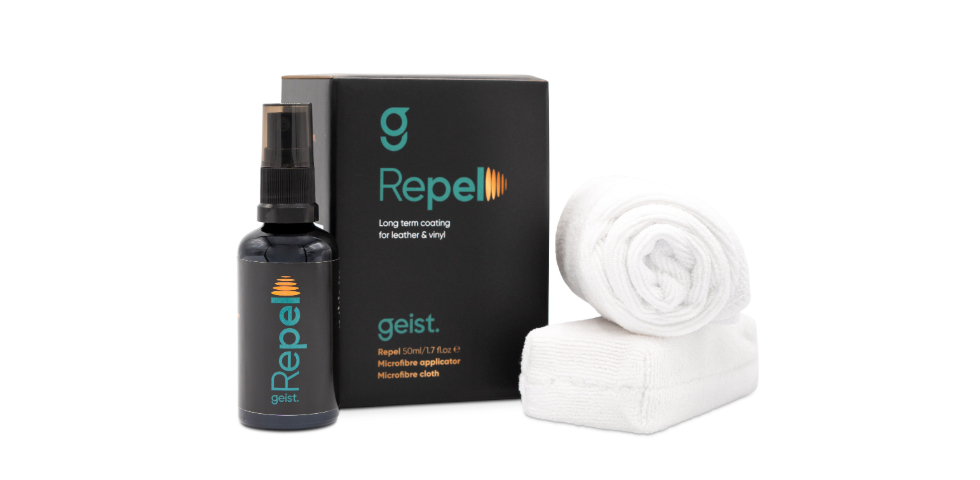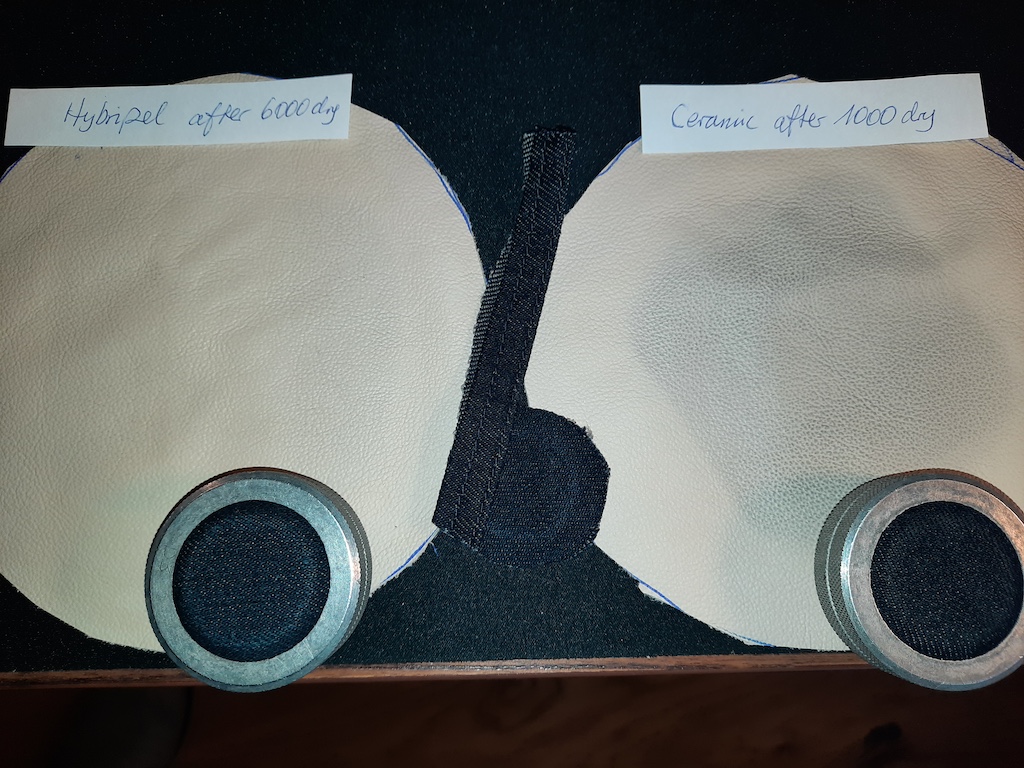Geist Repel: Solvent-free Long Term Seat Protection
by Reece @ DI
This article is written by Ram Iyer of Geist.
What is the most common damage to car seat surfaces during the first 6 months of use?
This question was asked by automotive development engineers in southern Germany in the 1990’s. The answer came from the statistics of customer service departments:
- scratches
- (non-removable) discolouration by jeans dye on entry bolsters…which often appeared on light coloured surfaces after in 2-3 weeks of use!
Scratches they understood, but “why dye all of a sudden?” they asked. It wasn’t an issue in the past! In the 1980’s major changes were made in the top-coat polymers (coatings) used on leather surfaces.
Removing solvents from leather topcoats had a large impact on soiling and scratch sensitivity.
Producers of automotive seating are required to fulfil high standards and one of these required that organic solvents were phased out (as much as possible) and replaced with water as the solvent in leather surface finishes. Dye migration into surfaces became a problem. In 1994 an early version of a leather protectant came on the market. It reduced scratching and slowed dye transfer with the help of PTFE (also known as Teflon) and with the use of microparticles.
Particles and PTFE:
Multiple such protective products are today sold. Most contain particles such as ceramic or crystalline silica, some with and some without organic solvent. Some even claim to be ‘permanent’. How do they function, and can they really be permanent?
The risks of applying solvent based coatings
to a flexible leather or synthetic seat surface are well known by the manufacturers. Solvents cause surface polymers to swell and weaken, if they are not wiped off immediately…and wiping solvent can remove important additives from seating surfaces, such as waxes and oils (plasticizers) added by the manufacturers to keep surfaces soft to touch and squeak free. Synthetics, (like vinyl or ‘vegan leather’) contain plasticizers or co-solvents to maintain flexibility, and these are removed, dissolved or displaced, by wiping with solvents.
How do particles like ceramics work?
Particles such as ceramics and silica crystals are held on car lacquer surfaces by polymers and reduce surface scratching by reducing the surface contact area, and by forming a barrier that is harder than most car lacquers are. Why then, are owners warned not to wash their coated car lacquer in a car wash? Because it is known that the repeated brushing and detergents used in car-wash equipment, do damage to these coatings. They have to be treated with care.
PTFE is a form of what we today call ‘forever chemicals’.
PTFE particles remain practically forever in the environment and their use, with a few exceptions, is being discontinued. Microscopic particles can be dangerous if swallowed or inhaled. The long-term effects of microparticles on human health and on the environment are just beginning to be researched and documented. They are also white and coatings with these particles can cause streaking on seat surfaces that can be difficult to remove.
‘Leather ‘breathability’:
Among the downsides of using microparticles bound in polymers on flexible seating surfaces, is the reduction of surface ‘breathability’, meaning that air and moisture movement through the leather micro-pores or structure of a surface can be greatly reduced by applying such layers.
Is this important?
High quality leather is a matrix, in some ways similar to a sponge, made of a layer of fibre bundles (called the ‘corium’)…and the dense surface layer, called the ‘grain’, which (similar to our skin), maintains its moisture level and thus its flexibility, (and also the comfort of the user), by letting air and water vapour continuously pass through multiple microscopic pores. Anyone who goes on a long walk wearing rubber gumboots (the British call them ‘Wellingtons’ or ‘Wellies’), finds out how uncomfortable non-permeable materials can be….because sweat and moisture cannot get out! This is why high-quality seating is very often perforated. Filling micropores with particles and surface ‘lacquer’ which holds them to the surface, reduces important quality parameters of automotive leather and of synthetic leather alternatives.
Vegan leather, light coloured leather and synthetics and a new kind of long-term protection.
Chemical engineering experts who participated in the Car Interior and Quality Perception conferences and committees that brought together the major German automotive, leather, synthetic surface, and seating industries, have recently developed a coating that claims to far exceed the protection offered by older solvent and particle-based coatings.
The innovation claimed by the developers, which they describe as a form of ‘hybrid polymer’, is a extremely thin, tough and durable coating that far outperforms all particle containing coatings in comparative testing under identical conditions.
It is also completely particle and solvent free.
Hybrid polymers are polymers that combine polymers with completely different chemical compositions; inorganic polymers consist of inorganic molecules such as metals, metalloids, and nonmetals, while organic polymers are made of carbon-based compounds. A hybrid polymer can combine the properties of inorganic polymers such as a (generally) higher thermal stability, higher chemical resistance, and mechanical toughness, to the versatility of an organic polymer such as flexibility, and in this case, a remarkable ability to prevent dye migration and to increase cleanability.
What is the cause of dye migration?
- Indigo (the most used blue dye for jeans), and other dyes, are generally applied to textiles in water. The textile colour intensity is related to the dye content.
- Some of the dye remains only partly fixed to the textile fibres.
- Movement with pressure between the contact surfaces releases unfixed dye.(This is not a problem at this stage as it can generally be wiped off).
- Moisture such sweat, rain or high air humidity, and fats in sweat or soiling, dissolve more dye from the fabric and ‘assist’ the dye in penetrating the surface polymer and to move deeper into the surface. This is called ‘dye migration’. The migrating dye is partly dissolved and can penetrate into the surface. This is often difficult to clean as it can be chemically bound to the surface polymers.

Lab test without Hybrid Polymer protection
How can dye rub-off and dye migration be prevented?
Particle coatings (e.g. ceramic or silica) can reduce friction between a textile and the seat surface so perform quite well in tests when the surface remains dry. Less dye is rubbed off. When however, sweat or moisture are present, particle coatings rapidly lose their functionality, and dyes freely penetrate the surface.
Particle coatings are also known to be damaged by firm brushing, and through contact with detergents and this is observed in comparative testing.
The hybrid coating developed in Germany for long-term protection of flexible surfaces, is water and detergent resistant, and continues to protect even after cleaning with a brush and a safe leather cleaner. It shows strong resistance to friction damage even after cleaning.
It is also free of solvents and carries no health or environmental warnings which makes it safe for even the most sensitive surfaces.
Outstanding features confirmed by professional users of the new hybrid-polymer coating are its soft, non-slippery touch and that it can dry invisibly. This is known to be important, in particular on black or dark surfaces that need the scratch protection properties of a tough coating.
Another feature that has not been available in traditional particle coatings is its ‘soil-release’ effect. All kinds of soiling, not just dye from jeans and clothing, are easier to remove if the leather or synthetic has been protected. A big plus for families and heavy users!
The UK based leather and auto-interior specialist Geist is introducing the first Hybrid Polymer coating under the name Geist Repel.
The almost complete invisibility of the Geist Repel hybrid polymer coating, along with its remarkable performance in comparative lab tests, is set to become the new benchmark for seat protection coatings.

Left: Geist Repel after 6000 cycles with dry jeans, followed by 20 cycles with damp jeans. Right: solvent based ceramic (silica) coating after 1000 cycles with dry blue jeans, followed by 20 cycles with damp jeans. Test carried out on cream OEM auto leather in 2024. (Test method following ISO 26082-1:2019)








No comments yet. Be the first!